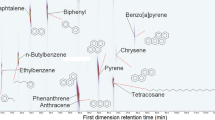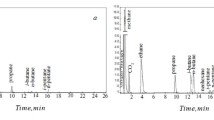Abstract
A scaled-up Chromatographic system was used to separate two close-boiling components, diethylether and dichloromethane, by gas-liquid chromatography. The system was composed of 12 segmented columns and sixty solenoid valves controlled by a programmable controller.
Effects of various flow paths on outlet concentration profiles were investigated to find optimum conditions. Compared to conventional preparative chromatography, moving feed-injection and productwithdrawal made it possible to separate the feed mixtures continuously in two sections, partition section and desorption section.
From the results of experiments, the operating principle of the desirable method was that within a certain time (switching time), less-absorbed component was obtained purely in the partition section, and in the desorption section the remained components were separated by increase in column length. Therefore, continuous separation can be achieved if the operations in the sections are performed within a switching time.
Similar content being viewed by others
Abbreviations
- A11,A4,A5 :
-
microneedle valves
- A4, A5 :
-
solenoid valves
- B:
-
manometers for adjustment of flow rates
- C:
-
feed reservoir
- D:
-
inlet of feed
- E:
-
outlet of feed
- F:
-
preheaters for carrier gas and desorbent
- G:
-
temperature controllers
- H1, H2 :
-
heating wires
- I:
-
main Chromatographic system
- J:
-
programmable controller
- K:
-
pressure gages
- L1, L3 :
-
gas chromatographs
- M:
-
multi-functional sampling valve
- N1, N2 :
-
bubble flow meters for carrier gas and desorbent
- O1-O5 :
-
thermocouples
- P:
-
electric heater
References
Littlewood, A.B.: “Gas Chromatography: Principles, Techniques and Applications”, 2nd Ed., Academic-Press, New York, (1966).
James, D.H. and Phillips, C.S.G.:J. Chem. Soc., 1600 (1953).
McNair, H.M. and Bonelli, E.J.: “Basic Gas Chromatography”, 5th Ed., varian instrument, Berkeley (1968).
King, C.J.: “Separation Processes”, 2nd Ed., McGraw Hill, N.Y. (1980).
Verzele, M.:J. Gas. Chrom.,3, 186 (1965).
Sussman, M.V.:CHEMTECH, 260 (1976).
Row, K.H. and Lee, W.K.:Korean. J. Chem. Eng.,3(1), 7 (1986).
Row, K.H. and Lee, W.K.:J. Chem. Eng. Japan,19, 173 (1986).
Husband, W.H., Barker, P.E. and Kini, K.D.: Trans. Instn. Chem. Engrs.,42, T387 (1964).
Chromosorb Diatomite Supports for Gas-Liquid Chromatography, Johns-Manville (1984).
Row, K.H. and Lee, W.K.: J. Chromatogr., in revision (1986).
Moon, I., Row, K.H. and Lee, W.K.:Korean J. Chem. Eng.,2(2), 155 (1985).
Author information
Authors and Affiliations
Rights and permissions
About this article
Cite this article
Row, K.H., Lee, W.K. Effect of flow paths on separation of binary components by gas-liquid chromatography. Korean J. Chem. Eng. 4, 23–28 (1987). https://doi.org/10.1007/BF02698095
Received:
Accepted:
Issue Date:
DOI: https://doi.org/10.1007/BF02698095




